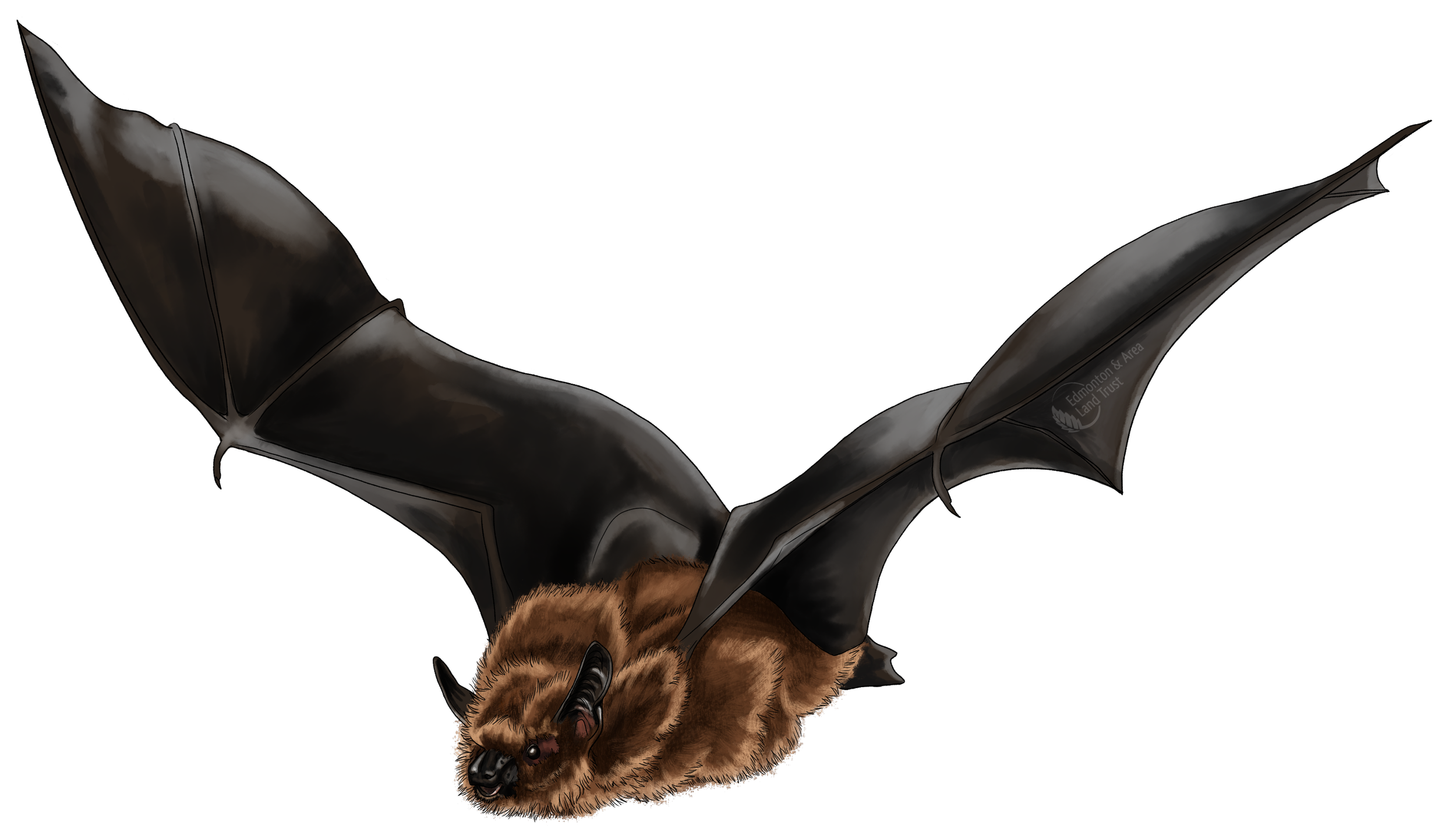Little Brown Bat (Myotis lucifugus)
Little brown bats are gentle and shy nocturnal, flying mammals. You may have glimpsed one flying by at night as they find their way through the dark, sending out ultrasonic pulses of sound and listening for the returning echoes to locate obstacles.
Little Brown Bat by Ann Froschauer, USFWS
Why they Matter to Us
Little brown bats are federally listed as Endangered.
A little brown bat will consume 600 to 1,000 mosquitoes, or mosquito-sized bugs, per hour, and eat more than half of their own body weight in insects each night!
A feasting colony of bats helps manage insect populations. Bats eat insects that are considered pests who transmit disease, destroy farmers' crops and impact forest stands.
Bats are perceived as evil creatures who turn into vampires and are a dark, spooky figure featured on many Halloween decorations.
Bats provide scientists with a model to study echolocation.
How You Can Help
Alberta Culture and Tourism volunteer day.
Support protected areas in the Edmonton region (such as EALT!). You can donate or volunteer your time to help with conservation efforts. Volunteers help to steward local natural areas by installing and monitoring bat boxes.
Build your own bat house!
Click here for instructions to build a Rocket Bat Box
Click here for instructions to build a Four Chambered Nursery Bat Box
Visit the Alberta Community Bat Program for more info on building and installing bat boxes in Alberta.
Sometimes bats roost in our buildings. If you happen along bat pups please remember they cannot fly and they still rely on their mothers. Bats reproduce very slowly for their size, and populations are slow to recover once lost. Click here for info on managing bats in buildings.
Don't install a bat box on your house, or other building where bats are not welcome roommates!
Bats can get caught and stuck in burdock, an invasive plant that produces spiky hooked burrs. Make your yard a safe habitat for bats by controlling invasive weeds like burdock.
How to Identify
You’ve probably seen a little brown bat zip past while you were sitting around an evening campfire. Did you know their wingspan can be as wide as 20 cm?
Identify by Sight
As the name suggests, the little brown bat is covered in brown fur, which is darker on their back and lighter on the front side.
Their wings are hairless and have a thin skin membrane stretched between the bat's extra long finger bones.
Adults generally weigh approximately 8.5 grams, and the females tend to be slightly larger than males.
Little Brown Bats by Ann Froschauer, USFWS
Identify by Sound
A maternity colony reveals its location during the day by the loud squeaking of the juveniles and scratching noises as the bats readjust position within the roost. Click here to listen to the sounds of a colony behind a barn wall.
As they fly, little brown bats emit clicking echolocation sounds. A bat detector can pick up these sounds to identify nearby bats.
Where to Find
The little brown bat is abundant all across Canada. In the summer, they roost in colonies in buildings such as barns, sheds, houses, schools, and office towers. When not in cities, the little brown bats will roost in trees. Over the winter months, the bats roost in caves or mines.
They occupy three to four types of roosts: day, night, nursery, and hibernation roosts. Day and night roosts are chosen based on stable ambient temperatures. Nursery roosts are warmer and are only occupied by females and their offspring. Hibernation roosts are often places with high humidity and temperatures above freezing. Some bats do leave Alberta in the winter, like some people!
Social Life
Little Brown Bats by Ann Froschauer, USFWS
Large numbers of little brown bats come together in mountain caves in the fall. This swarming activity creates a rapid turnover of individuals at each cave, creating ideal conditions for breeding. Hibernating females store sperm, and fertilization occurs in the spring.
After a gestation period of 50 - 60 days, the female gives birth to one pup. Mothers and their pups live together in a nursery colony. Mothers can identify their pups from their odor and squeaky calls.
Food Chain
The little brown bat is an opportunistic and efficient insect predator. They typically feed on swarms of insects to save their time and energy, catching them both in the air or gleaning them from flat surfaces like still water. Active bats can eat half their body weight in one night; talk about a full belly!
As a result of their nocturnal patterns, bats are kept safe from many predators. When they do venture out during the day, their biggest predators are great horned owls and magpies. Other opportunistic predators include cats, due to the close proximity of bat roosts to human establishments.
Little Brown Bat with White-nose Syndrome by Ann Froschauer, USFWS
White-nose Syndrome
White-nose Syndrome has seriously harmed bat populations in parts of Canada. White-nose syndrome is a fungus that grows on the nose and mouth of the bat and other areas of the body during hibernation. The fungus irritates the bat and wakes it up; in search of food, the bat either dies of starvation or exposure to the cold elements.
Fun Facts
Little brown bats can live up to 6 to 7 years of age
Alberta is home to 9 species of bats
The majority of bats found in winter roosts are males and the location of most females during the winter is unknown
Females return to the same nursery roost year after year
Bats hang upside down because it is more energy efficient to begin flying by letting gravity help them, rather than fighting gravity to lift off
There are over 1,000 species of bats in the world. They are the 2nd most abundant type of mammal, behind rodents





























